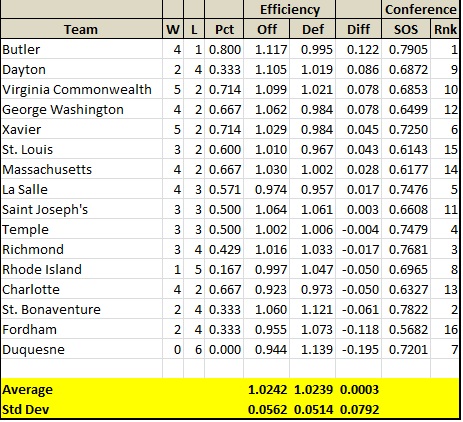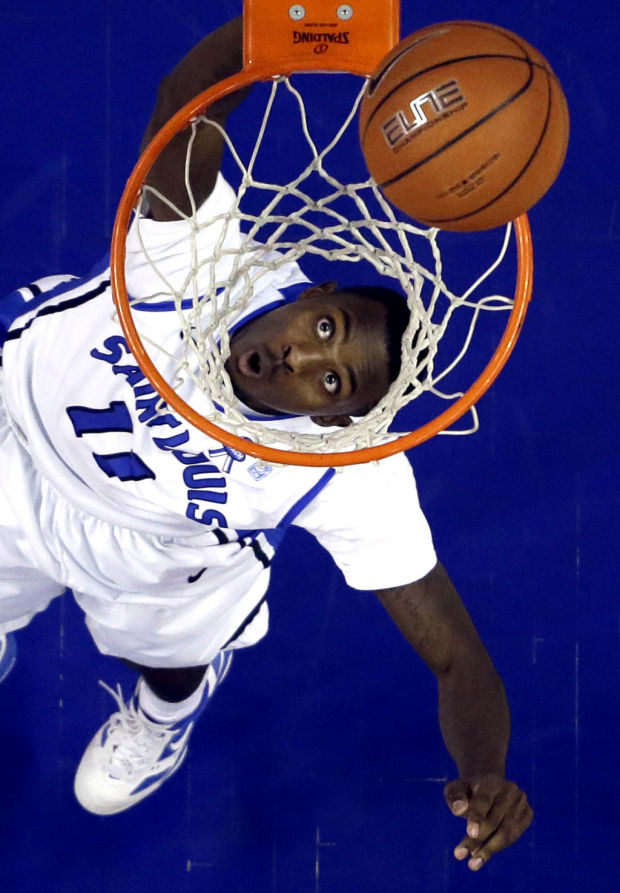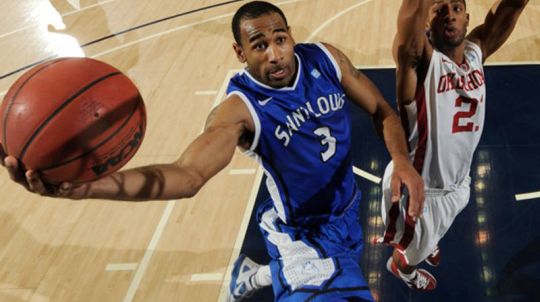CIO… the Atlantic 10 Conference
Posted by Brian Goodman on February 1st, 2013Joe Dzuback is the RTC correspondent for the Atlantic 10. You can also find his musings online at Villanova by the Numbers or on Twitter @vtbnblog.
[Ed. Note: this article was written prior to Thursday night’s St. Louis-Butler game.]
Looking Back
Difference Margins…Three Weeks into Conference Play: About 20% of the conference games are in the books, enough for the offensive and defensive efficiency (points per possession scored and allowed) margins provide some insight to race so far. I have included strength of schedule (conference games only) to provide a sense of how the schedule may have impacted the difference margin for any particular team.
Overall the margins appear to be behaving, about half of the conference teams have positive margins (offense greater than defense), and seven of those eight teams have winning records. The margins do not correspond exactly to the conference records, and those teams with divergent margins tend to draw out attention.
A few observations:
- Butler’s spot in the rankings is no surprise. Their #1 ranking in strength of schedule suggests the other numbers are going to hold up over the next six weeks.
- Fans familiar with difference margins from past seasons see Dayton in a familiar spot, as the Flyers’ record has typically run either ahead of their difference margin or well behind. This season the margin is far wider (and positive) than the record — back-to-back routs of Fordham and Duquesne are the reason. Expect the record and margin to close in the next two to three weeks.
- Charlotte appears to be the negative counterpart to Dayton. Huge road losses to Richmond and George Washington explain the negative margin, but a strength of schedule ranking of #13 suggest that the 4-2 record so far may be vulnerable.
Power Rankings
Upsets and inconsistent play add excitement to the conference race and jumble the rankings again this week. The question is how these unpredictable turns will affect the number of bids the conference garners at the end of the season. And whose phone will ring come Selection Sunday.
- Butler (17-4, 4-2, #9 AP) – The Bulldogs’ stumble (the first since late November) may have given La Salle a boost onto the bubble. Hopefully it will not cost them too much over the next six weeks. Rotnei Clarke is back and Kellen Dunham is blossoming, but the team’s recovery has been slow, especially in holding onto the ball, as they are in 10th in the league in turnover percentage.
- Virginia Commonwealth (17-5, 5-2) – The Rams’ defensive efficiency (points per possession allowed) has been rising steadily (see chart below) since the start of the conference season. In three of their last four games, coach Shaka Smart’s squad has allowed 1.0 point per possession or more (not good). Note that the offensive and defensive efficiency averages are curving towards each other, a trend that began after game #17 (the first conference game).
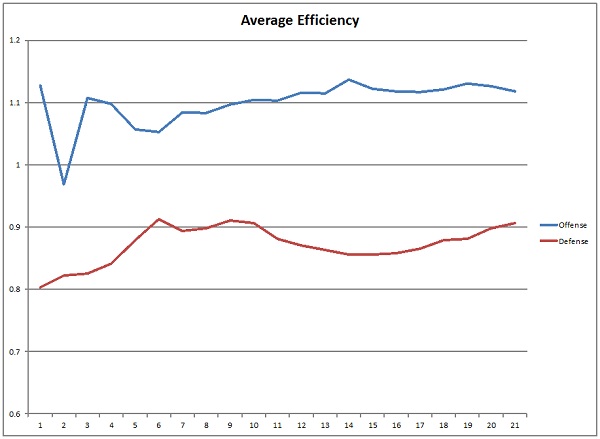 The only Havoc created lately seems to be in VCU’s offense. The next two games (Rhode Island and Fordham) should get those numbers back on track (and VCU back in the Top 25?), but their trip to Charlotte for their February 9 game should give fans a better idea whether the defense is back or that there are more problems on the horizon.
The only Havoc created lately seems to be in VCU’s offense. The next two games (Rhode Island and Fordham) should get those numbers back on track (and VCU back in the Top 25?), but their trip to Charlotte for their February 9 game should give fans a better idea whether the defense is back or that there are more problems on the horizon. - Xavier (12-8, 4-2) — The Musketeers have answered the bell…the one that opened the conference season. The 0-2 (Charlotte and Saint Joseph’s) road trip aside, coach Chris Mack’s team has handled all comers, at times with ease, averaging a nearly 7 point margin in their five conference wins so far. Xavier is off on another two game road trip, spanning the next 10 (give or take) days, that will have stops in Richmond and Duquesne. Road wins here are not givens. The Spiders, struggling in the absence of Derrick Williams, are hardly ready to roll over and Xavier needs to go 2-0 to continue their momentum.
- Saint Louis (14-5, 3-2) – The Billikens’ stumble versus Rhode Island was an extremely generous act that may well cost coach Jim Crews’ squad come Selection Sunday. Without undervaluing Rhodi’s efforts, the lapses from Mike McCall and Dwayne Evans were out of character for the two players and undermined St. Louis’ bid to control the game and pull out the win. The Bills may have corrected themselves, however, with an emphatic win over Butler at Chaifetz in which they generated 23 Bulldog turnovers and shot 58.5% on twos. VCU and La Salle also pay visits to the Gateway to the West before the end of the season.
- Temple (14-6, 2-3) – The Owls find themselves in unfamiliar territory, sitting at .500 and what are some of the worst defensive numbers since coach Fran Dunphy’s first year on North Broad. Ironically, the Owls’ defense is about average for the entire conference – a hint at how the program values defense. The players may well be a bit over aggressive on defense, putting their conference opponents at the free throw line about four times for every ten field goal attempts taken. Three players (Will Cummings, Khalif Wyatt and Rahlir Hollis-Jefferson) are ranked in Pomeroy’s top 500, giving Temple a #4 ranking in the conference for steals, but they could help themselves even more with more aggressive defense of the three point line. Their next two opponents, Saint Joseph and Charlotte, have conference records in the .500 range, much like Temple’s, so wins, aside from the “normal” benefit, would also push the Owls to the top of that cluster.
- Charlotte (16-4, 4-2) – How can the worst offense in the conference sport a 4-2 record? The 49ers also happen to have the second best defense in the conference. Coach Alan Major’s squad has scored 1.0 points per possession only once since conference play began, when they hosted Fordham (who have been defensively challenged this season) on January 16. This is a prescription for a long slow slide, unless Major can persuade Chris Braswell to share the ball with DeMario Mayfield and Willie Clayton (or at least dissuade him from taking three’s). Charlotte’s two losses, both on the road, were brutal affairs. The 49ers were down early and not competitive. They will have to figure that out, or their next two, with Massachusetts followed by Temple (on the road) could be ugly.
- La Salle (14-6, 4-2) – The Philadelphia Board of Health should test the Schuylkill’s water; like their two city conference mates, the Explorers exhibit definite bi-polar symptoms. After beating Virginia Commonwealth and Butler in back-to-back games, they dropped a one point decision to Massachusetts (at the Gola, no less). Dr. John Giannini’s squad puts out consistent solid defense, allowing 1.0 or more points per possession in only one of seven conference games to date. Their fate (literally) hinges on whether their shots drop, only twice in seven conference games has La Salle averaged 1.0 (or better) points per possession. Of the other five, the Explorers are 2-3. Getting to the free throw line (suggesting a somewhat passive offense) has been a problem too; the Explorers get a free throw for every four field goal attempts. Player of the Week Ramon Galloway will need to be on his game as the Explorers travel to Washington for a game with the surging Colonials. A following game with Fordham should provide a fire break should they lose on Saturday, but a 1-2 run after they knocked off the conference power houses would put a definite chill on any post season aspirations.
- Massachusetts (14-5, 3-2) – The Minutemen have strung back-to-back wins largely through a “good enough” defense. Since December 4 they have quietly compiled an 11-4 record and are poised to resurrect their post season prospects. Their win over La Salle was step one. Their game Saturday, versus a faltering Charlotte squad, could be step two. After Charlotte, coach Derek Kellogg’s squad will host a dangerous Rhode Island squad, but consider that a 2-0 run would give UMass a 6-2 record just passed the halfway mark in conference play. Granted their schedule is backloaded with games against Saint Joseph’s, Temple, Virginia Commonwealth, Xavier and Butler falling in the month between February 9 and March 7, but their confidence should be sky high.
- George Washington (10-9, 4-2) – GWU is on a nice three game winning run, the capstone coming last Saturday when they beat a surging Charlotte squad by 28 (82-54). The game bore all of the hallmarks of a Mike Lonergan-coached offense, efficient scoring inside the 20’ 9” line, board dominance and frequent trips to the free throw line. Turnovers, an ongoing problem for the young back court, were high (about 24% of their possessions) did not play a decisive role versus Charlotte. Going 2-0 over the next two games (versus La Salle and at Duquesne) would put the Colonials on a 5-0 run going into their game with Butler.
- Saint Joseph’s (13-7, 2-3) – The preseason consensus favorite has assembled a so-so record that screams inconsistency. Having lost games to Butler and Virginia Commonwealth (in overtime) by a respectable six points, the Hawks dropped a nine point decision – at home — to struggling St. Bonaventure. A solid win over Xavier is followed by a squeaker over Fordham. The Joe’s have the fourth-best offense in the conference, scoring 1.06 points per possession. They also have the fourth worst defense in the conference, allowing their opponents 1.06 points per possession – which explains how they came to be 3-3 in conference play. If the Hawks are to make a bid for NCAA consideration, they must run 4-0 over the next two weeks which features games with fellow bid-hopefuls Temple and Massachusetts, along with offense-minded Dayton (remember the Joe’s defense?) and Richmond. Coach Phil Martelli survived a job scare in 2010 when fans, frustrated with consecutive 20 loss seasons (the first in the program’s history), called for his head. A late season run offered a glimpse of what the squad’s potential, and that muffled the rumble. With raised expectations this season, another fan revolt might be harder to handle.
- Richmond (13-9, 3-3) – Wins over Charlotte and Virginia Commonwealth have proven illusionary, as the impact of Derrick Williams’ loss has taken a toll. Since leaving the Davidson game on December 29, the Spiders have compiled a 4-5 record.
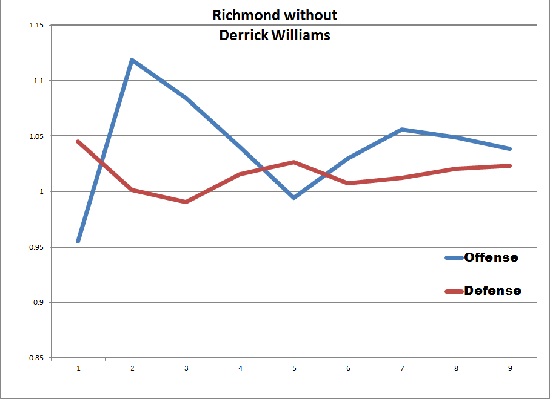 While Richmond’s offense has registered several strong performances in Williams’ absence (see chart above), when the rolling average of Richmond’s points per possession scored and allowed is charted, the long term decline of the Spiders’ defense (the rising red line) is unmistakable. Harder times are ahead as coach Chris Mooney’s squad face Xavier, Saint Louis and Saint Joseph’s – all of whom have scored on average more than 1.0 points per possession — in the run-up to Saint Valentine’s Day.
While Richmond’s offense has registered several strong performances in Williams’ absence (see chart above), when the rolling average of Richmond’s points per possession scored and allowed is charted, the long term decline of the Spiders’ defense (the rising red line) is unmistakable. Harder times are ahead as coach Chris Mooney’s squad face Xavier, Saint Louis and Saint Joseph’s – all of whom have scored on average more than 1.0 points per possession — in the run-up to Saint Valentine’s Day.- Dayton (12-8, 2-3) – The Good News – Dayton has the second best offense in the conference (conference games only). The Bad News – that rating is based largely on hot three point shooting (a 46% completion rate), complements of role players Dyshawn Pierre, Matt Derenbecker and Khari Price. Kevin Dillard, the squad’s most prolific three-point shooter, converts at a respectable 39% rate, but the admittedly potent offense has not translated into wins (and Dillard is unmentioned in Player of the Year talk). The Flyers are 0-4 in conference games where they have allowed their opponent to score more than 1.0 points per possession. They may not be able to turn it around soon, as Saint Louis and Saint Joseph’s are up next. The Billikens score an average of 1.01 per possession, while the Joe’s rank third in conference offense, scoring an average of 1.06 in conference games so far.
- Saint Bonaventure (9-10, 2-4) – Despite a successful foray into Philadelphia where they beat La Salle and Temple, the Bonnies are staring at large step back if they cannot right the ship defensively. Offensively coach Mark Schmidt’s squad is holding It’s own in conference play, but allowing opponents to complete 57% of their two-point field goal attempts is generous to a fault and just the most obvious of their defensive woes. Demitrius Conger will have to step up and help out on the backboard. Duquesne over the weekend should get Bona another “W”, but a road trip that takes in Butler followed by a hungry Rhode Island squad could be trouble.
- Fordham (6-15, 2-3) – Coach Tom Pecora has to thank the Lord he is in the same conference as Duquesne and Rhode Island this season. The Rams’ difference margin is on track to finish just above where it has finished the last two seasons (in the -0.240 range) – a disappointing lack of progress for the program — but Duquesne is running well behind. Two wins is a little ahead of last season’s – complements of Duquesne and Rhode Island – but Rhodi has a single win, with small prospects to garner a second one in the last six weeks. With 11 games left in the season, the prospects for Chris Gaston to break Ed Conlin’s career record for points scored is fading. The senior forward will need to average 26.4 points per game to surpass Conlin’s 1886 point margin.
- Rhode Island (6-13, 1-4) – What the coaching staff at Rhode Island continues to accomplish this season amazes me each week. The conference record reads 1-4, but the average margin in those four losses is 3.8 points. The Rams have no quit. The next four games pose the greatest challenge however. Virginia Commonwealth, Butler and Massachusetts are a mid-season Murderer’s Row that Rhodi will have to survive before they host St. Bonaventure on February 9. The Bonnies game is the last best chance for a second conference win, but will coach Dan Hurley’s scrappers have enough left to give St. Bonaventure a fight? Stay tuned.
- Duquesne (7-13, 0-6) – The challenge for coach Jim Ferry and the Dukes is to play every game. With a freshman starting point guard (Derrick Colter) and several others on the wing (Quevyn Winters and Jeremiah Jones), fatigue – mental and physical – may become a controlling factor in the next six weeks. The team’s efficiency difference (offensive points per possession – defensive points per possession – see Table01 above) is -0.1953 this week. If that margin grows over February, expect things to get ugly by season’s end. Fordham-level ugly, a margin of -0.247 to end the 2009 season for example, is entirely possible, especially if the defense continues to flag.
Reader’s Take
Looking Ahead
The conference has about 30% of the games on the books. The next week will is about the last stretch in the schedule where a postseason hopeful can take an “overlooked” loss.
- Saint Joseph’s vs. Temple (Saturday February 2, 6:00 PM, CBS Sports Network) – The Owls need this Big 5 game not only for local pride, but to build momentum for an NCAA bid. The Owls have a slight edge in the back court; Saint Joseph’s front court will have to take control of the boards and (given Khalif Wyatt’s tendency to drive the basket) the lane to give themselves the best chance to win.
- George Washington vs. La Salle (Saturday February 2, 2:00 PM) – The Colonials have a young (and exciting) back court, but this one will probably turn on how well George Washington values the ball. Their guards can be turnover prone, and La Salle can force turnovers. The front court matchups, La Salle’s Jerrell Wright and Steve Zack will be challenged by a team that looks for scoring opportunities inside 20’ 9” far more than outside.





























